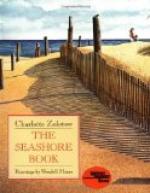The country boy, too, sees this Gull. He flies far inland, following the plough, and he then rids the land of many a harmful grub. Because of this habit, some people call him the Sea-crow. At all seaside places you find him, and there he fights for his meals with the Herring Gull, the Common Gull, the Kittiwake and others.
Really we should call this gull the Brown-headed, not the Black-headed, Gull; for the hood is more brown than black; and again, if you look for this bird during your summer holidays, you will see no dark hood on his head. You might, though, know him then by the red legs and bill, and the white front-edging to his lovely pearly-grey wings.
Look at him in January, however, and you see dark feathers beginning to appear on his head. The fact is, this dark hood is the bird’s wedding dress. It comes only when the nesting season draws near. Then he leaves the fields, parks, and rivers, to fly away to the nesting-place.
These Gulls love to nest in colonies—that is, near one another. Among rushes and reeds, and rough grass growing in deep wet mud, they feel that their nests are safe. There they lay three eggs. The chicks, almost as soon as they leave the eggs, can run about. If there is no dry land near the nest, these youngsters tumble in the water and swim without bothering about swimming lessons.
In summer they are ready to fly with their parents round the coast, and to the muddy mouths of large rivers, where they feed. Flocks of them are also seen out in the open sea, feeding on the shoals of small fish. They also follow steamers, for the sake of any scraps thrown overboard, and they crowd round the fishing boats when they are being unloaded. You see, they are scavengers, and so are to be found wherever there are waste scraps of food.
Perhaps you have noticed that Gulls float high in the sea, like so many corks. They can leave the water easily, and take to flight; but they cannot dive. The Gull’s dinner-table is the whole coast. His eyes are keen enough, as you will know if you have watched him swoop down on a piece of bread in mid-air, and catch it neatly in his beak.
The flight of this Gull is beautiful, graceful, and easy. Sometimes he wheels up and up into the blue sky, almost without moving a wing. He can also glide for a great while, balancing his body against the wind, and turning his head from side to side on the look-out for food. Those long, pointed wings of his make him one of Nature’s most perfect flying-machines. His wild, laughing cry has given him the nickname of Laughing Gull.
In the fields and along the banks of our big rivers you may see the Common Gull with numbers of his black-headed cousins. His beak and legs and webbed feet are greenish yellow, and this is quite enough to distinguish the two birds. Their habits are much the same. Both skim over the sea, or the coast, looking for waste food. They are not very “choice” in their meals; dead fish or live fish, young crabs, worms, shell-fish or grubs they eat readily, as well as any offal thrown from passing ships, or the refuse of the fish-market.




